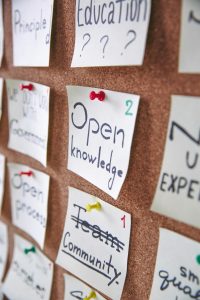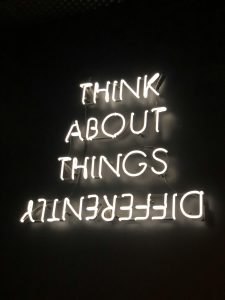1.1 Identification and Definition
The United States and the rest of the world face many social problems such as poverty and hunger, racism and sexism, drug use and violence, and climate change, to name just a few. Why do these problems exist? What are their effects? What can be done about them? We will explore these challenges, addressing their origins, consequences, and potential solutions through the application of contemporary critical thinking methods and theory and research from sociology and other social sciences.
As we embark on this journey to understand the social problems we face, we must first learn to identify and define them. A social problem refers to any situation or behavior that negatively affects a significant number of people and is widely acknowledged as a matter that requires attention. This definition comprises both an objective aspect, based on observable consequences, and a subjective aspect, rooted in collective recognition.
In accordance with the objective aspect an issue must harm or negatively impact a significant number of individuals to be labeled a social problem. How do we know if a social problem has negative consequences? Reasonable people can and do disagree on whether such consequences exist and, if so, on their extent and seriousness, but ordinarily a body of data accumulates from academic studies, government agencies, and various sources to strongly indicate widespread and significant repercussions. The reasons for these consequences are often hotly debated, and sometimes, as we shall see throughout this book, the very existence of these consequences is disputed. For example, while a significant majority of climate scientists assert the reality and severity of climate change, a 2011 survey revealed that less than two-thirds of Americans (64%) expressed the belief that global warming is occurring (Leiserowitz 2010).
This discrepancy underscores the subjective aspect of defining social issues, emphasizing the necessity for a collective acknowledgment that a specific condition or behavior merits attention to be recognized as a social problem. This component lies at the heart of the social constructionist view of social problems (Rubington and Weinberg 2011). The social constructionist view of social problems posits that societal issues are not inherent or objective realities but are instead products of subjective interpretations, cultural values, and power dynamics within a given social context. According to this perspective, there are various negative conditions and behaviors. Some are deemed negative enough to be labeled as social problems, while others don’t gain this designation. Additionally, certain conditions or behaviors are only recognized as social problems when individuals, policymakers, or other groups bring attention to them.
The shift in attention to rape and sexual assault in the United States from the 1970s onward illustrates this latter scenario. While instances of sexual violence against women likely occurred throughout history and were prevalent in the U.S. before the 1970s, they were largely overlooked by legal authorities, college textbooks, and the media (Allison and Wrightsman 1993). Many people regarded rape and sexual assault as commonplace events. However, with the emergence of the contemporary women’s movement in the late 1970s, there was a concerted effort to recognize these acts as serious crimes and reflections of women’s inequality. This increased focus led to a change in public awareness, altered perceptions of these crimes, and prompted legal policymakers to address them more seriously. In essence, sexual violence against women evolved into a recognized social problem.
The social constructionist perspective prompts an intriguing question about rape and sexual assault. When does a social problem truly become one? According to certain sociologists embracing this viewpoint, negative conditions and behaviors aren’t deemed social problems unless recognized as such by policymakers, large segments of the public, or other societal groups. Hence, these sociologists argue that rape and sexual assault before the 1970s weren’t considered social problems since they received minimal attention from society at large. However, contrasting sociologists assert that negative conditions and behaviors should be regarded as social problems even if they attract little or no attention. In this view, rape and sexual assault before the 1970s are seen as social problems despite the limited societal acknowledgment at the time.
This ongoing debate bears a resemblance to the timeless question, “If a tree falls in a forest and no one is there to hear it, does it make a sound?” Similar to this enigma, it’s not a straightforward answer, but it underscores a fundamental tenet of the social constructionist perspective. Perception holds as much, if not more, importance than reality. Aligned with this principle, social constructionism emphasizes that individuals, interest groups, policymakers, and other entities often vie to shape public perceptions of various conditions and behaviors. They seek to influence how these issues are portrayed in the media, shaping public perspectives on the severity and nature of negative consequences, the underlying reasons for the condition or behavior in question, and potential solutions to the problem.

The emphasis on perception in social constructionism leads to a thought-provoking idea, a condition or behavior might not be acknowledged as a social problem despite a substantial basis for this perception, and conversely, it might be considered a social problem even with little or no basis for this perception. A historical instance illustrating the latter scenario is the “issue” of women in college. During the late 1800s, prominent physicians and medical researchers in the United States authored journal articles, textbooks, and newspaper columns advising women against pursuing higher education. The rationale behind this advice was they were concerned that the challenges of college life might negatively impact women’s menstrual cycles, and they also worried that women wouldn’t perform well in exams during their menstrual periods (Ehrenreich and English 2005). We have gained better understanding since then, but the biased beliefs of these authors transformed the concept of women attending college into a social problem and contributed to the reinforcement of restrictions by colleges and universities on admitting women.
In a similar scenario, different entities can manipulate certain facets of an existing social problem, politicians might deliver speeches, the news media could employ sensational headlines and extensive coverage to grab the attention of readers or viewers, and businesses might use advertising to influence news coverage. The news media’s reporting on violent crime offers numerous instances of this phenomenon (Robinson 2011; Surette 2011). The news media tends to sensationalize violent crime, which is less frequent than property crimes such as burglary and larceny. By disproportionately highlighting stories about violent crime, media coverage fuels public anxiety about crime. Moreover, media narratives about violent crime are often more prevalent when the accused perpetrator is Black and the victim is White or when the offender is a juvenile. This kind of reporting is believed to reinforce public biases against African Americans and contribute to unfavorable perceptions of teenagers.
Understanding social constructionism and the process of identifying and defining social problems is connected to the skill of critically evaluating and analyzing social conditions, settings, and political motivations. To enhance our ability to comprehend and address social problems, we need to engage in various facets of critical thinking, improving our skills as thinkers and decision-makers. Acquiring critical thinking skills is a gradual process that requires consistent practice. By doing so, we enhance our rationality and reduce dependence on our subjective perspective.
The Value of Critical Thinking
Critical thinking is the capacity to approach decisions and ideas with clear and rational thinking (Lau and Chan 2004-2024). It involves the skill to think independently and reflectively. A person with critical thinking skills can:
- Comprehend the logical relationships among decisions and ideas.
- Recognize, form, and assess arguments.
- Spot inconsistencies and typical errors in reasoning.
- Systematically address problems.
- Discern the significance and relevance of decisions and ideas.
- Reflect on the justification for one’s own beliefs and values.
A critical thinker can draw consequences from their knowledge, apply information to solve problems, and seek pertinent sources of information to stay informed.

Critical thinking should not be mistaken for being argumentative or overly critical of others. While these skills can be applied to identify mistakes and flawed reasoning, critical thinking also plays a crucial role in collaborative reasoning and constructive tasks. It aids in acquiring knowledge, refining theories, and reinforcing arguments. By employing critical thinking, we can improve work processes and enhance social institutions.
Some individuals think that critical thinking limits creativity since it involves adhering to the principles of logic and rationality. However, critical thinking is entirely consistent with thinking creatively, challenging established norms, and exploring unconventional approaches. If anything, critical thinking is a fundamental component of creativity because it enables us to assess and enhance our creative ideas.
Developing Critical Thinking Skills
The ability to think clearly and rationally is beneficial in all areas of our lives. Effective problem-solving and systematic thinking help understand and tackle social issues. Scientific pursuits require the thoughtful use of reason in both experimentation and confirming theories. A successful democracy depends on citizens who can employ critical thinking about social issues to shape their evaluations of governance and to overcome biases and prejudice.
Critical thinking is a metacognitive skill, signifying that it operates at a higher cognitive level, involving “thinking about thinking” (Lau and Chan 2004-2024). It entails an awareness of sound reasoning principles and reflection on our thought processes. Moreover, it frequently demands a deliberate commitment to self-improvement, overcoming biases, and sustaining objectivity, which can be challenging. While everyone possesses the ability to think, honing the skill of effective thinking often necessitates prolonged training. Like mastering various skills, proficiency in critical thinking involves three crucial elements: theory, practice, and attitude.
If we want to think correctly, we need to follow the correct rules of reasoning. Knowledge of theory includes knowledge of these rules (Lau and Chan 2004-2024). These are the basic principles of critical thinking, such as the laws of logic, and the methods of scientific reasoning, etc.
Also, understanding what to avoid is valuable for correct reasoning. This implies acquiring basic knowledge about common mistakes, including typical fallacies (faulty reasoning) and misconceptions. Furthermore, psychologists have identified enduring biases and limitations in human reasoning. Familiarity with these helps us recognize potential issues in our thinking.
However, simply understanding the principles that differentiate effective and ineffective reasoning is insufficient. Unless we actively practice critical thinking, we may struggle to apply it when needed. Developing proficiency in critical thinking involves internalizing theoretical principles so that they become second nature in our daily lives. There are at least two approaches to achieve this. One is engaging in a variety of high-quality exercises, which extend beyond formal classroom activities to include discussions and debates in our daily interactions. The other method involves delving deeper into the principles we’ve learned. In the human mind, memory and comprehension are enhanced by establishing connections between ideas.
Effective critical thinking skills require more than just knowledge and practice. Consistent improvement through practice is possible only when accompanied by the right kind of motivation and attitude. Certain attitudes, while not uncommon, can hinder critical thinking:
- A preference for receiving correct answers rather than figuring them out independently.
- A reluctance to engage in deep thought about decisions, relying solely on gut feelings.
- A tendency to avoid reviewing mistakes.
- Discomfort with receiving criticism.
To enhance our thinking abilities, it’s crucial to recognize the significance of reflecting on the reasons behind our beliefs and actions. Additionally, we should be open to engaging in debates, breaking old habits, and addressing the complexities of language and abstract concepts.
The California Critical Thinking Disposition Inventory is a psychological assessment designed to gauge individuals’ disposition towards critical thinking. It assesses seven distinct thinking habits, prompting us to reflect on the extent to which they align with our thinking:
- Truth-seeking: Are you committed to understanding things as they truly are? Is seeking the truth of interest to you?
- Open-mindedness: How open are you to new ideas, even those that initially conflict with your intuition? Do you give them a fair consideration?
- Analyticity: Are you inclined to understand the reasons behind things, or do you make impulsive decisions without evaluating pros and cons?
- Systematicity: Is your thinking systematic? Do you break down complex problems into manageable parts?
- Confidence in Reasoning: Do you always defer to others, or do you have confidence in your own judgment? Can you articulate the reasons behind your confidence and evaluate your thinking?
- Inquisitiveness: How curious are you about the world around you?
- Maturity of Judgment: Do you tend to jump to conclusions, or do you consider various perspectives and incorporate others’ experiences?
Additionally, psychologists have identified cognitive biases that can influence human reasoning, such as overconfidence and a tendency to focus on evidence that supports pre-existing opinions. It’s crucial to be aware of these biases in our attitudes toward our own thinking.
Fostering a Social Analytic Mindset
Subjective reality refers to the notion that perception and personal experiences shape an individual’s understanding of the world, meaning that reality can vary significantly from one person to another based on their perspectives, beliefs, and emotions. This contrasts with objective reality, which is independent of individual biases and interpretations. Alternative facts, a term popularized in contemporary political discourse, refers to statements or assertions that deviate from established, evidence-based facts, often presenting a skewed or false version of reality. The concept of alternative facts undermines the notion of a shared, objective truth by promoting subjective realities that can be manipulated for various agendas, leading to confusion and misinformation.
Metacognition is knowing more about our thinking processes and being able to monitor and control them (Lau and Chan 2004-2024). Critical thinking must involve some metacognition because we need to become aware of our own reasoning and find ways to improve it.
Developing into a proficient and effective thinker involves more than merely acquiring knowledge of logic and other reasoning principles. It necessitates self-awareness to comprehend our individual strengths and weaknesses. A grasp of human psychology, including awareness of common cognitive biases influencing our decisions, is also crucial. Furthermore, the practical application of theoretical knowledge is contingent on possessing the appropriate personality and attitude. Traits like persistence in problem-solving and a robust commitment to self-improvement are valuable attributes that contribute to the long-term enhancement of our thinking skills.
The mind is a powerful tool with limitless potential to shape countless realities through consciousness as its framework, ultimately enabling individuals to live life to the fullest. Mindset represents the human inclination to conclude conscious thought processes in the form of perspectives, providing meaning to one’s life.
Having a disciplined and reflective mindset is crucial for enhancing thinking abilities and developing a social analytic mindset. This involves tasks like ensuring accuracy, evaluating progress, and making well-informed decisions regarding time and mental effort allocation in problem-solving or solving social issues. Scholars like Tishman, Jay, and Perkins (1993) and Halpern (1998) emphasize the self-monitoring and self-regulatory aspects of metacognition, which include being attentive to our reasoning and tracking our progress. While it’s important to be aware of our thinking, we often overestimate our abilities and underestimate our vulnerability to biases. Furthermore, there is a need to cultivate social and cultural awareness, emotional intelligence, leadership and self-management skills. To foster a social analytic mindset, we must take responsibility for our own learning and personal growth, considering our unique circumstances. This involves placing critical thinking within a broader framework of higher-order cognitive skills, enabling us to embark on a lifelong journey of self-development.
Creative Problem Solving
For many individuals, creativity is often associated with scientists or artists, overlooking the fact that we encounter numerous challenges in our daily lives. Creative thinking is instrumental in devising solutions to these problems, whether we’re contemplating how to increase income or enhance the well-being of our loved ones (Lau and Chan 2004-2024).
There is a common misconception that creativity is a realm of waiting for inspiration to strike. The process of generating inspiring ideas is sometimes viewed as mysterious, and certain individuals are considered inherently more creative than others. However, it would be incorrect to perceive creativity as a passive state of mind. While there might not be a specific algorithm for creativity, there are teachable thinking skills and actionable steps to boost one’s creativity. To embark on this journey, it’s crucial to grasp three fundamental principles that underlie creativity.
Principle one: New ideas are composed of old elements
Critical thinking primarily revolves around accurate thinking, whereas creativity explores alternative possibilities, aiming to generate novel and valuable ideas. These ideas could manifest as new theories, products, solutions to problems, or concepts for artistic endeavors.
Creativity involves producing something distinctive and special, necessitating a readiness to deviate from the ordinary and the traditional. Many people tend to adhere to instructions and shy away from challenging the status quo or exploring new territory. This underscores the importance of possessing a courageous, exploratory attitude, and curiosity.
But where do new ideas originate? The straightforward answer is that new ideas essentially rearrange old ones in a fresh manner. In this context, the saying “there is nothing new under the sun” holds true. This principle applies to conceptual or theoretical creations and to the initiation of new fashions or cultural trends.
The process of generating new ideas from old ones typically involves combining different elements, altering or removing certain components. Take the example of a mobile phone—an amalgamation of the ideas of wireless information transmission and a telephone.
Practically, this principle suggests that the creative ingredients one can access depend on the reservoir of ideas available for recombination. A limited knowledge domain translates to fewer resources for forming new ideas. Intellectual curiosity and a broad knowledge base can significantly augment creativity, providing access to a diverse array of concepts, theories, and experiences. Seeking solutions by consulting individuals with different expertise can also prove beneficial.
Principle two: Not all new ideas are equal
Creativity extends beyond merely generating new ideas; it involves the ability to produce novel and valuable ideas that fulfill crucial needs or initiate impactful trends.
Creativity can be categorized into cognitive and artistic forms. Artistic creativity involves creating artwork and expressing ideas and emotions through various art forms. While critical thinking is not in opposition to artistic creativity, enhancing critical thinking skills may not necessarily improve artistic creativity. However, critical thinking is imperative for cognitive creativity, which revolves around devising solutions to practical or theoretical problems, such as formulating a new scientific theory or launching a commercial product.
Cognitive creativity comprises two facets, generating new ideas and evaluating and modifying them. Critical thinking plays a vital role in assessing the relevance and effectiveness of ideas when tackling problems. Constructing a rocket to reach the moon requires adherence to logical principles and the laws of physics. Therefore, the evaluation of any proposal must incorporate sound critical thinking.
While it is suggested that creativity may sometimes demand defying conventional norms, it is essential to recognize that good critical thinking doesn’t imply perpetual criticism. If experience indicates the usefulness of brainstorming or temporarily setting aside critical judgment to generate and list new ideas before evaluation, it is a rational approach. This aligns with the principles of critical thinking, dispelling the misconception that critical thinking and cognitive creativity are mutually exclusive.
Principle three: Creativity thrives on detecting connections between ideas
While our store of ideas provides the raw materials for generating new ones, it is crucial to acknowledge that valuable ideas may emerge from unexpected sources. Successful marketing campaigns, for instance, might draw on psychological studies and relate to societal trends. This requires recognizing connections between the specific subject of interest (the marketing exercise) and seemingly unrelated subjects (sociology and psychology).
Consider the example of the “fastskin” swimsuits introduced by Speedo around 1996. Designing a swimsuit for athletes involves minimizing drag, and researchers drew inspiration from sharks’ V-shaped ridges. Emulating sharkskin, the swimsuits reduced drag and turbulence, proving highly successful at the Sydney Olympics in 2000.
To foster creativity, it is essential to explore connections between different domains. This involves building a broad knowledge base, as creative individuals often read widely, possess a strong sense of curiosity, and explore topics without immediate benefits. Additionally, the learning process should aim for a profound understanding of connections between key concepts, ensuring that information is examined from various angles and systematically reformulated for better comprehension.
The Creativity Cycle
Certainly, there is no precise formula for ensuring creativity. However, the following informal procedure has proven quite useful, resembling the working routines of many successful individuals. While it may appear straightforward, success results from the consistent application of this procedure over an extended period.
Step 1. Research
When confronted with the task of generating ideas to address a problem, it is beneficial to conduct research and explore existing knowledge on the topic. If effective solutions already exist, there’s no need to reinvent the wheel. However, even in unsolved scenarios, understanding existing approaches and their limitations is crucial. During the initial research phase, gather a wealth of information without concerning yourself too much about relevance.

Some useful actions to take:
- Obtain relevant information from scientific literature or consult experts.
- Investigate the historical context of the problem.
- Conduct case studies on individuals who have tackled similar issues.
- Consider analogous situations.
- Engage with the people directly involved.
Step 2. Explore the connections between ideas
While collecting data, engage in preliminary study to gain deeper insights into the problem. Whether during or after data collection, reflect on the gathered information, assess its importance, and identify potential connections between ideas. Creativity often involves transferring concepts from one field and applying them in another.
Step 3. Relax and wait
Many of us have experienced moments where ideas spontaneously emerge during activities like showering or after a good night’s sleep. While sorting out connections between ideas, persistence is crucial. Allocate an extended period to keep various ideas in mind, allowing some to remain in the background, possibly entering unconscious thinking processes. After intense efforts, it’s essential to step back, engage in relaxing activities, and stimulate the mind differently. This may involve forgetting less important ideas to let more relevant ones surface. Allowing time for ideas to gestate is crucial. If a breakthrough is elusive, further research and exploration of connections may be necessary.
Step 4. Apply, review, and follow up
Upon generating potential ideas, carefully examine them to ensure they address the problem. Evaluate whether improvements are possible and determine the implementation process. Even successful ideas should undergo thorough review, seeking ways to enhance the overall process for future endeavors.
Creative heuristics
If the essence of creativity lies in manipulating ideas, it’s essential to explore various methods that can aid in generating testable ideas. Below, we present some heuristics or mental shortcuts that can be beneficial:
A feature list for an object or process is essentially a compilation of its primary features. Once such a list is obtained, one can systematically examine each feature and contemplate potential modifications. For instance, a conventional table has a fixed, round or rectangular flat top supported by one or more poles. A creatively designed table might feature movable, multi-level worktops of irregular shapes supported by a wire frame.
Utilizing analogies can assist in envisioning new features. By comparing X with Y, one can explore whether unique features of Y could find analogues in X. For example, thinking of an airplane as a bird prompts consideration of applying evolutionary solutions for aviation in birds to the construction of aircraft. Similarly, a novel swimsuit designed to reduce drag for swimmers was inspired by the features of shark skins.
Sometimes, problem-solving involves sifting through a lengthy list of potential solutions. In such cases, employing a systematic search method becomes crucial. Thomas Edison, when designing the electric light bulb, faced the task of searching for a suitable filament—conducting electricity well enough to emit light but resistant to burning up or melting. He classified different material types (ceramic or metallic) systematically to narrow down the search. When dealing with a vast search space, dividing it into segments and conducting a systematic search, along with tests on representative samples, helps eliminate unlikely candidates.

When tackling a problem involving people, considering the issue from different perspectives can be valuable. For instance, when aiming to enhance a company’s efficiency, one can explore the problem from the CEO’s viewpoint or from the perspective of the sales department. Shifting between different perspectives may uncover difficulties or opportunities not previously considered.
Perspective shift also entails contemplating various ways of formulating a problem. If fixated on a particular aspect during a challenge, reformulating the problem can unveil new approaches. For example, a developer faced with the task of clearing a significant amount of topsoil might shift their perspective. Instead of viewing it as an expense, they might discover that the soil quality is suitable for farming, presenting an opportunity to sell the soil. Occasionally, setting aside preconceptions and exploring alternative viewpoints is necessary, as Einstein noted when asked about the most helpful event in developing his theory of relativity, “Figuring out how to think about the problem.”
Group creativity
Numerous books and courses on creativity focus on enhancing individual creative abilities. However, in the contemporary workplace, collaborative efforts are often essential for solving intricate problems. Major companies structure projects around teams with specialized expertise, and research in science and technology is increasingly conducted by collaborative teams.
While many creative thinking techniques for groups exist, brainstorming stands out as one of the most well-known. Coined by advertising executive Alex Osborn (1979) in his book “Applied Imagination,” brainstorming involves a group meeting to generate numerous new ideas. The key requirement is to foster idea production by refraining from criticisms or negative feedback.
Despite its popularity, the efficacy of brainstorming is sometimes overstated due to various challenges:
- Unclear objectives or unstructured discussions can lead to diffuse and impractical ideas.
- Reluctance to share ideas may arise from fear of judgment.
- Group fixation on the initial perceived solution may hinder exploration of alternatives.
- Time-consuming discussions may cause individuals to forget or abandon their ideas.
- Dominance by vocal individuals can stifle diverse contributions.

To address these challenges, a more effective implementation of brainstorming involves giving individuals time to write down their ideas or forming smaller sub-groups for preliminary discussions. This allows for open and, if necessary, anonymous idea collection and discussion, focusing on how to implement ideas rather than critiquing them.
Another potential pitfall in group creativity is groupthink, where a closely-knit group with a uniform culture becomes resistant to challenging its own ideas. This hinders innovative breakthroughs. Counteracting groupthink may require efforts to bring in new members or rotate group membership. Additionally, asking team members to adopt opposing roles for debates can foster a more dynamic and critical environment.
Pitfalls of creativity
Creativity is a highly prized quality, and education aims to foster students’ creativity and problem-solving skills. Businesses are eager to invest in hiring creative individuals. However, is there a downside to creativity?
Empirical research suggests statistical correlations between creativity and personality traits such as introversion, emotional sensitivity, openness to new experiences, and impulsivity. In more extreme cases, creativity is often associated with emotional disorders, particularly in the realm of creative arts (Akinola and Mendes 2008). Harvard psychologist Howard Gardner (2011), in his renowned book “Creating Minds,” examined the lives of creative figures like Einstein, Freud, and Picasso. He asserted that a common thread among these individuals is a Faustian bargain, where they make significant sacrifices in other areas of life to pursue their creative endeavors. Gardner highlighted the creators’ intense devotion to their work missions, often at the expense of a well-rounded personal existence.
Recent experiments by Professor Francesca Gino and behavioral economist Dan Ariely suggest a link between creativity and dishonesty. Creative individuals, according to their findings, are more prone to dishonesty and cheating. In fact, creativity was identified as a better predictor of unethical behavior than intelligence (Gino and Ariely 2012).
Successful creativity often results from focused, prolonged efforts, implying sacrifices in other aspects of life. It requires a certain personality type to sustain such intense dedication to a project. Traits like stubbornness and grit enable individuals to persist through failures and adhere to their goals. Moreover, the courage to break existing rules and embrace uniqueness underlies the exploration of new territories. While more research is needed on the connections between creativity, personality, and psychological factors, it’s evident that becoming a creative person involves more than learning thinking rules; various psychological factors play a crucial role.
APPLYING A SOCIAL ANALYTIC MINDSET
Self-Reflection: Critical Thinking Strategies
- Read and take notes on the book excerpt entitled Critical Thinking in Everyday Life: 9 Strategies by Richard Paul and Linda Elder (2001).
- Read and take notes on the blog entitled College Info Geek: 7 Ways to Improve Your Critical Thinking Skills by Thomas Frank (2017).
- Complete and record your answers to the Approach to Learning: Self-Assessment created by the University of British Columbia.
- Finally, write a response discussing the strengths and barriers in your thinking patterns and behaviors as identified in the readings and self-assessment results. Address the following questions as you develop your response: a) In what areas or techniques is your critical thinking deficient and how might these deficiencies influence your learning? b) What good critical thinking habits do you practice that help or reinforce your ability to learn? c) How might you improve your critical thinking, cognitive learning skills, and decision-making?
“Self-Reflection: Critical Thinking Strategies” by Vera Kennedy, Lemoore College is licensed under CC BY 4.0
